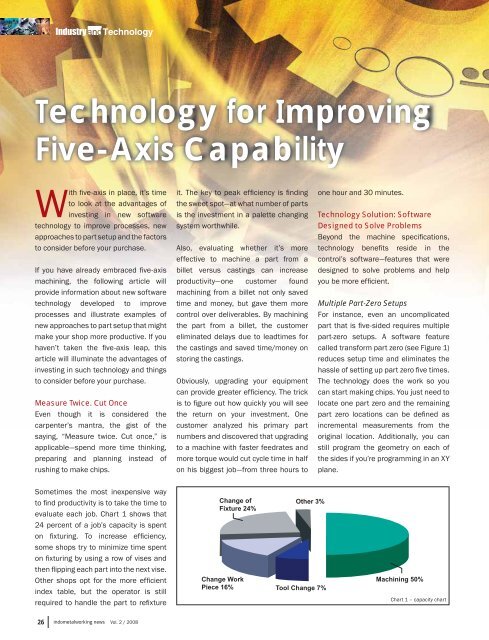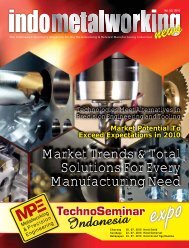High Speed Machining Precision Tooling - Indobiz.biz
High Speed Machining Precision Tooling - Indobiz.biz
High Speed Machining Precision Tooling - Indobiz.biz
Create successful ePaper yourself
Turn your PDF publications into a flip-book with our unique Google optimized e-Paper software.
Technology for Improving<br />
Five-Axis Capability<br />
With fi ve-axis in place, it’s time<br />
to look at the advantages of<br />
investing in new software<br />
technology to improve processes, new<br />
approaches to part setup and the factors<br />
to consider before your purchase.<br />
If you have already embraced fi ve-axis<br />
machining, the following article will<br />
provide information about new software<br />
technology developed to improve<br />
processes and illustrate examples of<br />
new approaches to part setup that might<br />
make your shop more productive. If you<br />
haven’t taken the fi ve-axis leap, this<br />
article will illuminate the advantages of<br />
investing in such technology and things<br />
to consider before your purchase.<br />
Measure Twice. Cut Once<br />
Even though it is considered the<br />
carpenter’s mantra, the gist of the<br />
saying, “Measure twice. Cut once,” is<br />
applicable—spend more time thinking,<br />
preparing and planning instead of<br />
rushing to make chips.<br />
it. The key to peak effi ciency is fi nding<br />
the sweet spot—at what number of parts<br />
is the investment in a palette changing<br />
system worthwhile.<br />
Also, evaluating whether it’s more<br />
effective to machine a part from a<br />
billet versus castings can increase<br />
productivity—one customer found<br />
machining from a billet not only saved<br />
time and money, but gave them more<br />
control over deliverables. By machining<br />
the part from a billet, the customer<br />
eliminated delays due to leadtimes for<br />
the castings and saved time/money on<br />
storing the castings.<br />
Obviously, upgrading your equipment<br />
can provide greater effi ciency. The trick<br />
is to fi gure out how quickly you will see<br />
the return on your investment. One<br />
customer analyzed his primary part<br />
numbers and discovered that upgrading<br />
to a machine with faster feedrates and<br />
more torque would cut cycle time in half<br />
on his biggest job—from three hours to<br />
one hour and 30 minutes.<br />
Technology Solution: Software<br />
Designed to Solve Problems<br />
Beyond the machine specifi cations,<br />
technology benefi ts reside in the<br />
control’s software—features that were<br />
designed to solve problems and help<br />
you be more effi cient.<br />
Multiple Part-Zero Setups<br />
For instance, even an uncomplicated<br />
part that is fi ve-sided requires multiple<br />
part-zero setups. A software feature<br />
called transform part zero (see Figure 1)<br />
reduces setup time and eliminates the<br />
hassle of setting up part zero fi ve times.<br />
The technology does the work so you<br />
can start making chips. You just need to<br />
locate one part zero and the remaining<br />
part zero locations can be defi ned as<br />
incremental measurements from the<br />
original location. Additionally, you can<br />
still program the geometry on each of<br />
the sides if you’re programming in an XY<br />
plane.<br />
Sometimes the most inexpensive way<br />
to fi nd productivity is to take the time to<br />
evaluate each job. Chart 1 shows that<br />
24 percent of a job’s capacity is spent<br />
on fi xturing. To increase effi ciency,<br />
some shops try to minimize time spent<br />
on fi xturing by using a row of vises and<br />
then fl ipping each part into the next vise.<br />
Other shops opt for the more effi cient<br />
index table, but the operator is still<br />
required to handle the part to refi xture<br />
Change of<br />
Fixture 24%<br />
Other 3%<br />
Change Work<br />
Piece 16% Tool Change 7%<br />
<strong>Machining</strong> 50%<br />
Chart 1 – capacity chart<br />
26<br />
indometalworking news Vol. 2 / 2008




